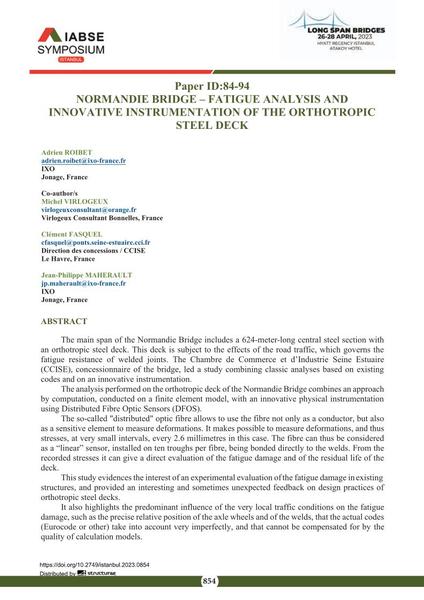Normandie Bridge – Fatigue Analysis and Innovative Instrumentation of the Orthotropic Steel Deck

|
|
|||||||||||
Détails bibliographiques
| Auteur(s): |
Adrien Roibert
(IXO, Jonage, France)
Michel Virlogeux (Virlogeux Consultant Bonnelles, France) Clément Fasquel (Direction des concessions / CCISE Le Havre, France) Jean-Philippe Maherault (IXO, Jonage, France ) |
||||
|---|---|---|---|---|---|
| Médium: | papier de conférence | ||||
| Langue(s): | anglais | ||||
| Conférence: | IABSE Symposium: Long Span Bridges, Istanbul, Turkey, 26-28 April 2023 | ||||
| Publié dans: | IABSE Symposium Istanbul 2023 | ||||
|
|||||
| Page(s): | 854-861 | ||||
| Nombre total de pages (du PDF): | 8 | ||||
| Année: | 2023 | ||||
| DOI: | 10.2749/istanbul.2023.0854 | ||||
| Abstrait: |
The main span of the Normandie Bridge includes a 624-meter-long central steel section with an orthotropic steel deck. This deck is subject to the effects of the road traffic, which governs the fatigue resistance of welded joints. The Chambre de Commerce et d’Industrie Seine Estuaire (CCISE), concessionnaire of the bridge, led a study combining classic analyses based on existing codes and on an innovative instrumentation. The analysis performed on the orthotropic deck of the Normandie Bridge combines an approach by computation, conducted on a finite element model, with an innovative physical instrumentation using Distributed Fibre Optic Sensors (DFOS). The so-called "distributed" optic fibre allows to use the fibre not only as a conductor, but also as a sensitive element to measure deformations. It makes possible to measure deformations, and thus stresses, at very small intervals, every 2.6 millimetres in this case. The fibre can thus be considered as a “linear” sensor, installed on ten troughs per fibre, being bonded directly to the welds. From the recorded stresses it can give a direct evaluation of the fatigue damage and of the residual life of the deck. This study evidences the interest of an experimental evaluation of the fatigue damage in existing structures, and provided an interesting and sometimes unexpected feedback on design practices of orthotropic steel decks. It also highlights the predominant influence of the very local traffic conditions on the fatigue damage, such as the precise relative position of the axle wheels and of the welds, that the actual codes (Eurocode or other) take into account very imperfectly, and that cannot be compensated for by the quality of calculation models. |
||||
